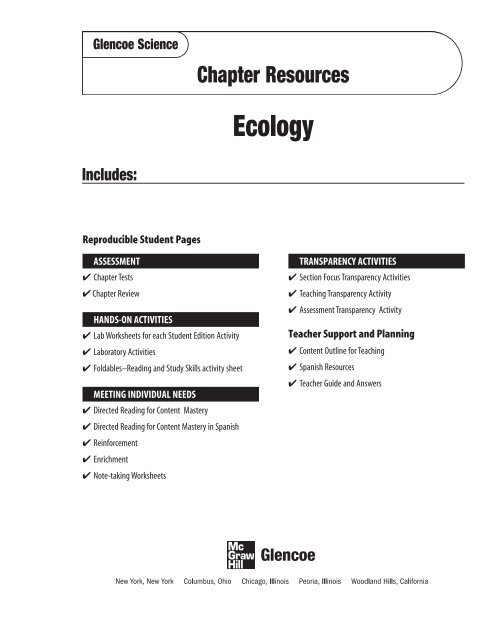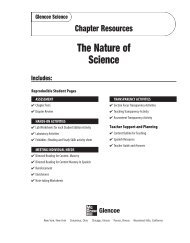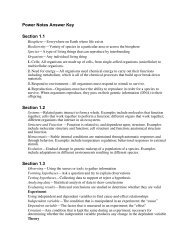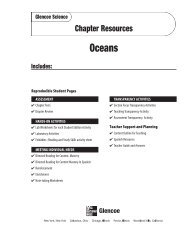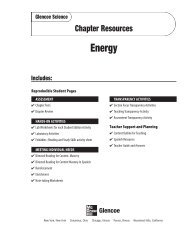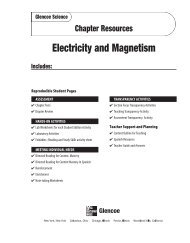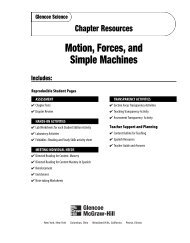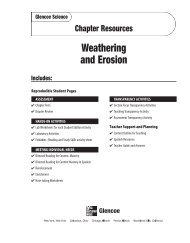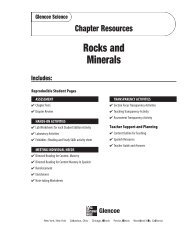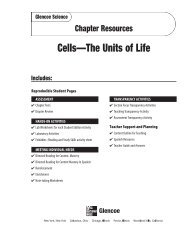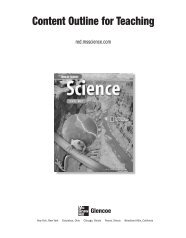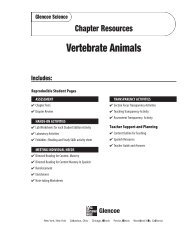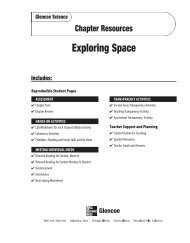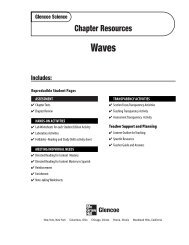Chapter 21 Resource: Ecology
Chapter 21 Resource: Ecology
Chapter 21 Resource: Ecology
- No tags were found...
Create successful ePaper yourself
Turn your PDF publications into a flip-book with our unique Google optimized e-Paper software.
Glencoe Science<strong>Chapter</strong> <strong>Resource</strong>s<strong>Ecology</strong>Includes:Reproducible Student PagesASSESSMENT✔ <strong>Chapter</strong> Tests✔ <strong>Chapter</strong> ReviewHANDS-ON ACTIVITIES✔ Lab Worksheets for each Student Edition Activity✔ Laboratory Activities✔ Foldables–Reading and Study Skills activity sheetMEETING INDIVIDUAL NEEDS✔ Directed Reading for Content Mastery✔ Directed Reading for Content Mastery in Spanish✔ Reinforcement✔ Enrichment✔ Note-taking WorksheetsTRANSPARENCY ACTIVITIES✔ Section Focus Transparency Activities✔ Teaching Transparency Activity✔ Assessment Transparency ActivityTeacher Support and Planning✔ Content Outline for Teaching✔ Spanish <strong>Resource</strong>s✔ Teacher Guide and Answers
Glencoe SciencePhoto CreditsSection Focus Transparency 1: Kevin Chan/istockphoto inc.Section Focus Transparency 2: Thomas Frame/istockphoto inc.Section Focus Transparency 3: Martina Misar/istockphoto inc.; (inset) Steven Roorda/istockphoto inc.Copyright © by The McGraw-Hill Companies, Inc. All rights reserved.Permission is granted to reproduce the material contained herein on the conditionthat such material be reproduced only for classroom use; be provided to students,teachers, and families without charge; and be used solely in conjunction with the<strong>Ecology</strong> program. Any other reproduction, for use or sale, is prohibited withoutprior written permission of the publisher.Send all inquiries to:Glencoe/McGraw-Hill8787 Orion PlaceColumbus, OH 43240-4027ISBN 0-07-867829-3Printed in the United States of America.1 2 3 4 5 6 7 8 9 10 024 09 08 07 06 05 04
To the TeacherThis chapter-based booklet contains all of the resource materials to help you teachthis chapter more effectively. Within you will find:Reproducible pages for■ Student Assessment■ Hands-on Activities■ Meeting Individual Needs (Extension and Intervention)■ Transparency ActivitiesA teacher support and planning section including■ Content Outline of the chapter■ Spanish <strong>Resource</strong>s■ Answers and teacher notes for the worksheetsHands-On ActivitiesMiniLAB and Lab Worksheets: Each of these worksheets is an expanded version of each laband MiniLAB found in the Student Edition. The materials lists, procedures, and questionsare repeated so that students do not need their texts open during the lab. Write-on rules areincluded for any questions. Tables/charts/graphs are often included for students to recordtheir observations. Additional lab preparation information is provided in the Teacher Guideand Answers section.Laboratory Activities: These activities do not require elaborate supplies or extensive pre-labpreparations. These student-oriented labs are designed to explore science through a stimulatingyet simple and relaxed approach to each topic. Helpful comments, suggestions, andanswers to all questions are provided in the Teacher Guide and Answers section.Foldables: At the beginning of each chapter there is a Foldables: Reading & Study Skillsactivity written by renowned educator, Dinah Zike, that provides students with a tool thatthey can make themselves to organize some of the information in the chapter. Students maymake an organizational study fold, a cause and effect study fold, or a compare and contraststudy fold, to name a few. The accompanying Foldables worksheet found in this resourcebooklet provides an additional resource to help students demonstrate their grasp of theconcepts. The worksheet may contain titles, subtitles, text, or graphics students need tocomplete the study fold.Meeting Individual Needs (Extension and Intervention)Directed Reading for Content Mastery: These worksheets are designed to provide studentswith learning difficulties with an aid to learning and understanding the vocabulary andmajor concepts of each chapter. The Content Mastery worksheets contain a variety of formatsto engage students as they master the basics of the chapter. Answers are provided in theTeacher Guide and Answers section.Copyright © Glencoe/McGraw-Hill, a division of the McGraw-Hill Companies, Inc.iv
Directed Reading for Content Mastery (in Spanish): A Spanish version of the DirectedReading for Content Mastery is provided for those Spanish-speaking students who arelearning English.Reinforcement: These worksheets provide an additional resource for reviewing the conceptsof the chapter. There is one worksheet for each section, or lesson, of the chapter.The Reinforcement worksheets are designed to focus primarily on science content and lesson vocabulary, although knowledge of the section vocabulary supports understanding ofthe content. The worksheets are designed for the full range of students; however, they willbe more challenging for your lower-ability students. Answers are provided in the TeacherGuide and Answers section.Enrichment: These worksheets are directed toward above-average students and allow themto explore further the information and concepts introduced in the section. A variety offormats are used for these worksheets: readings to analyze; problems to solve; diagramsto examine and analyze; or a simple activity or lab which students can complete in theclassroom or at home. Answers are provided in the Teacher Guide and Answers section.Note-taking Worksheet: The Note-taking Worksheet mirrors the content contained in theteacher version—Content Outline for Teaching. They can be used to allow students to takenotes during class, as an additional review of the material in the chapter, or as study notesfor students who have been absent.Copyright © Glencoe/McGraw-Hill, a division of the McGraw-Hill Companies, Inc.Assessment<strong>Chapter</strong> Review: These worksheets prepare students for the chapter test. The<strong>Chapter</strong> Review worksheets cover all major vocabulary, concepts, and objectivesof the chapter. The first part is a vocabulary review and the second part is a concept review.Answers and objective correlations are provided in the Teacher Guide and Answers section.<strong>Chapter</strong> Test: The <strong>Chapter</strong> Test requires students to use process skills and understand content.Although all questions involve memory to some degree, you will find that your students willneed to discover relationships among facts and concepts in some questions, and to use higherlevels of critical thinking to apply concepts in other questions. Each chapter test normallyconsists of four parts: Testing Concepts measures recall and recognition of vocabulary andfacts in the chapter; Understanding Concepts requires interpreting information and morecomprehension than recognition and recall—students will interpret basic information anddemonstrate their ability to determine relationships among facts, generalizations, definitions,and skills; Applying Concepts calls for the highest level of comprehension and inference;Writing Skills requires students to define or describe concepts in multiple sentence answers.Answers and objective correlations are provided in the Teacher Guide and Answers section.Transparency ActivitiesSection Focus Transparencies: These transparencies are designed to generate interestand focus students’ attention on the topics presented in the sections and/or to assessprior knowledge. There is a transparency for each section, or lesson, in the Student Edition.The reproducible student masters are located in the Transparency Activities section. Theteacher material, located in the Teacher Guide and Answers section, includes TransparencyTeaching Tips, a Content Background section, and Answers for each transparency.v
Teaching Transparencies: These transparencies relate to major concepts that will benefitfrom an extra visual learning aid. Most of these transparencies contain diagrams/photosfrom the Student Edition. There is one Teaching Transparency for each chapter. The TeachingTransparency Activity includes a black-and-white reproducible master of the transparencyaccompanied by a student worksheet that reviews the concept shown in the transparency.These masters are found in the Transparency Activities section. The teacher material includesTransparency Teaching Tips, a Reteaching Suggestion, Extensions, and Answers to StudentWorksheet. This teacher material is located in the Teacher Guide and Answers section.Assessment Transparencies: An Assessment Transparency extends the chapter content andgives students the opportunity to practice interpreting and analyzing data presented incharts, graphs, and tables. Test-taking tips that help prepare students for success on standardizedtests and answers to questions on the transparencies are provided in the TeacherGuide and Answers section.Teacher Support and PlanningContent Outline for Teaching: These pages provide a synopsis of the chapter by section,including suggested discussion questions. Also included are the terms that fill in the blanksin the students’ Note-taking Worksheets.Spanish <strong>Resource</strong>s: A Spanish version of the following chapter features are included in thissection: objectives, vocabulary words and definitions, a chapter purpose, the chapter Activities,and content overviews for each section of the chapter.Copyright © Glencoe/McGraw-Hill, a division of the McGraw-Hill Companies, Inc.vi
ReproducibleStudent PagesReproducible Student Pages■ Hands-On ActivitiesMiniLAB: Observing Soil Characteristics . . . . . . . . . . . . . . . . . . . . . . . 3MiniLAB: Try at Home Calculating Population Density . . . . . . . . . . . 4Lab: Ecosystems in a Bottle . . . . . . . . . . . . . . . . . . . . . . . . . . . . . . . . . . 5Lab: Design Your Own What’s the limit? . . . . . . . . . . . . . . . . . . . . . . . 7Laboratory Activity 1: Dozens of Daisies—Population Density . . . . . . 9Laboratory Activity 2: Food Webs: Who eats whom? . . . . . . . . . . . . . 11Foldables: Reading and Study Skills. . . . . . . . . . . . . . . . . . . . . . . . . . 13■ Meeting Individual NeedsExtension and InterventionDirected Reading for Content Mastery . . . . . . . . . . . . . . . . . . . . . . . 15Directed Reading for Content Mastery in Spanish . . . . . . . . . . . . . . 19Reinforcement . . . . . . . . . . . . . . . . . . . . . . . . . . . . . . . . . . . . . . . . . . 23Enrichment. . . . . . . . . . . . . . . . . . . . . . . . . . . . . . . . . . . . . . . . . . . . . 26Note-taking Worksheet . . . . . . . . . . . . . . . . . . . . . . . . . . . . . . . . . . . 29■ Assessment<strong>Chapter</strong> Review . . . . . . . . . . . . . . . . . . . . . . . . . . . . . . . . . . . . . . . . . 33<strong>Chapter</strong> Test . . . . . . . . . . . . . . . . . . . . . . . . . . . . . . . . . . . . . . . . . . . . 35■ Transparency ActivitiesSection Focus Transparency Activities . . . . . . . . . . . . . . . . . . . . . . . . 40Teaching Transparency Activity . . . . . . . . . . . . . . . . . . . . . . . . . . . . . 43Assessment Transparency Activity . . . . . . . . . . . . . . . . . . . . . . . . . . . 45<strong>Ecology</strong> 1
Hands-On ActivitiesHands-OnActivities2 <strong>Ecology</strong>
Name Date ClassObserving Soil CharacteristicsProcedure1. Fill two cups with soil. Use different amounts of the materials available tocreate two different “soil recipes.” Pack the soil equally into each cup.2. Pour equal amounts of water into each cup.3. After a minute or so, tip the cups over to see if any water pours out.4. Observe the characteristics of the soils you made. Record your observationsin the data table.Observations of SoilsHands-On ActivitiesCup ACup BCopyright © Glencoe/McGraw-Hill, a division of the McGraw-Hill Companies, Inc.Analysis1. What was the difference between the soil in the two cups to start with?2. Was there a difference in how the soil in each cup held water? What could this mean for plantsor other organisms living in the soil?<strong>Ecology</strong> 3
Name Date ClassHands-On ActivitiesCalculating Population DensityProcedure1. Calculate the total area of your home by multiplying the length times thewidth of each room and adding all the products together.2. Count the number of people who live in your home.3. Divide the number of people living in your home by the total area to determinethe population density.AnalysisCalculate what would happen to the population density if the number of people living in yourhome doubled?Copyright © Glencoe/McGraw-Hill, a division of the McGraw-Hill Companies, Inc.4 <strong>Ecology</strong>
Name Date ClassEcosystem in a BottleLab PreviewDirections: Answer these questions before you begin the Lab.1. What will you put in the plastic bottle?Hands-On Activities2. At what level should you keep the water? What kind of water should you use to replace waterthat evaporates?You may think of ecosystems as large areas. But ecosystems can be any size.You can even make an ecosystem that fits in a plastic bottle.Copyright © Glencoe/McGraw-Hill, a division of the McGraw-Hill Companies, Inc.Real-World QuestionWhat are the parts of an ecosystem?Goals■ Model an ecosystem.■ Observe an ecosystem.Materials2-L bottlescissorssandaquarium gravelmetric rulerwaterElodea plantsguppyfish foodSafety PrecautionsProcedure1. Rinse out a 2-L plastic bottle with water.Using scissors, carefully cut off the top ofthe bottle.2. Pour a layer of sand 5 to 10 cm deep in thebottom of the bottle.3. Fill the bottle to within 5 cm of the topwith water that has stood in an open containerfor about two days. Keep a supply ofthis aged water on hand to replace thewater that evaporates from the bottle. Thelevel should always be about the same.4. Plant the Elodea and add a 2-cm layer ofgravel. Place the container in bright lightbut not direct sunlight.5. When the water clears, add a guppy.6. Feed the fish one or two small flakes offood every day.7. Observe your ecosystem every day andrecord your observations in the table inthe Data and Observations section. Be sureto include observations about the livingand nonliving parts of your ecosystem.<strong>Ecology</strong> 5
Name Date Class(continued)Hands-On ActivitiesData and ObservationsEcosystem ObservationsDay Living parts Nonliving partsDay 1Day 2Day 3Day 4Day 5Day 6Day 7Day 8Day 9Day 10Day 11Day 12Day 13Day 14Conclude and Apply1. Describe how the parts in the bottle work together to form an ecosystem.2. Explain what is needed to keep the ecosystem healthy.Communicating Your DataCopyright © Glencoe/McGraw-Hill, a division of the McGraw-Hill Companies, Inc.Keep a daily journal explaining what you do each day to take care of your ecosystem anddescribing any changes that take place over time.6 <strong>Ecology</strong>
Name Date Class(continued)Hands-On ActivitiesFollow Your Plan1. Make sure the teacher has approved your plan and your data table before you proceed.2. Carry out your plan.3. Record your observations during the experiment.4. Complete your data table in your Science Journal.Analyze Your Data1. Make a graph to show your results. Use a bar graph to compare the number of seedlings that grewin the experimental containers with the number of seedlings that grew in the control containers.2. Identify the variables in your experiment.3. Identify the controls in your experiment.Conclude and Apply1. Explain how the abiotic factor you tested affected the bean plant population.2. Predict what would happen to your plant population if you added another kind of plant oranimal to the containers.Communicating Your DataCopyright © Glencoe/McGraw-Hill, a division of the McGraw-Hill Companies, Inc.Compare your results with other groups. Explain how different factors affected the plantsgrown by each group.8 <strong>Ecology</strong>
Name Date ClassCopyright © Glencoe/McGraw-Hill, a division of the McGraw-Hill Companies, Inc.1LaboratoryActivityDozens of Daisies—Population DensityOne way ecologists describe populations is by finding out how many individual organisms livein a certain area. This number is called the population density, which is found by dividing thenumber of organisms in the population by the area where a population lives. This will tell youhow much space or room each organism has. In this experiment, pretend you are an ecologistwho has made a map of three different populations of daisies. Now, find the population density ofthese populations using the formula below.Population Density = Number of Organisms/AreaExample: An ecologist counted 16 oak trees in a 1-acre plot in a forest.Population Density = 16 oak trees/1 acrePopulation Density = 16 oak trees per acreStrategyYou will find the area of each plot of daisies.You will count the number of daisies in eachpopulation.You will calculate the population density ofeach daisy population.MaterialspencilrulerProcedure1. Look at the map of Daisy Population A inFigure 1. Find the area of the plot whereDaisy Population A lives.a. Use a ruler to measure the length andwidth of the three plots. Record yourmeasurements in Data Table 1. For allthree maps, 1 cm on the map is equal to1 m on the ground.b. To find the area of each plot, multiply itslength by its width. Record your measurementsas square meters (m 2 ) in DataTable 1.2. Count the number of daisies (dots) in DaisyPopulation A in Figure 1. Record your datain Data Table 1. Draw a line through eachdot as you count it—this will stop you fromcounting the same daisy twice.3. Use the data you collected to calculate thepopulation density of Daisy Population A.Record your answers in the Data andObservations section.4. Repeat steps 2 and 3 for Daisy PopulationsB and C.5. Look quickly at Daisy Populations A, B,and C in Figure 1. Make a hypothesis as towhich population has the highest density.Which has the lowest?Figure 1Scale: 1 cm = 1 mDaisy Population ADaisy Population BDaisy Population CHands-On Activities<strong>Ecology</strong> 9
Name Date ClassLaboratory Activity 1 (continued)Hands-On ActivitiesData and ObservationsData Table 1LengthPopulation of Plot (m)Widthof Plot (m)Areaof Plot (m)Number ofDaisiesABC6. What is the population density of each population?a. A = _____________ b. B = _____________ c. C = _____________Questions and Conclusions1. Which daisy population had the greatest population density? The lowest? Were your originalhypotheses correct?2. What would happen to the population density of Daisy Population A if the number of daisieswere reduced by half?3. What would happen to the population density of Daisy Population C if the area were doubled?4. Which population of daisies would be most limited by limiting factors?Strategy CheckCan you calculate the area of a plot?Can you count the number of organisms in a population?Using your measurements, were you able to calculate the population density of yourdaisy populations?Do you understand how population size and area can change population density?Copyright © Glencoe/McGraw-Hill, a division of the McGraw-Hill Companies, Inc.10 <strong>Ecology</strong>
Name Date ClassCopyright © Glencoe/McGraw-Hill, a division of the McGraw-Hill Companies, Inc.2Food Webs: Who eats whom?Animals and plants need energy to carry out life’s activities. Plants are producers. They get theirenergy from the Sun. Animals are consumers. They get their energy by eating plants or other animalsor organisms. A food chain is a simple model that shows how energy passes from organismto organism. In an ecosystem, there are many different food chains. A food web is a model thatshows all of the energy relationships among organisms. In this experiment, you will look at organismsfrom a forest ecosystem and create a model food web.StrategyYou will identify producers and consumers.You will create a model of a food web.Materialsblack pen or markerglue or tapegreen construction paperposter boardred construction paperscissorsyarn or stringProcedure1. Figure 1 shows a forest ecosystem. The listbeside Figure 1 shows the names of someof the different plants and animals that livein this ecosystem. Take some time andthink about how these organisms interact.Figure 1LaboratoryActivity2. Cut out three medium-sized circles fromthe green construction paper.3. Cut out four medium-sized circles from thered construction paper.4. Plants and other organisms that producetheir own food are called producers. Fromthe list beside Figure 1, use a black markeror pen to write the name of a producer oneach of your green circles.5. Organisms that obtain their energy by eatingother organisms are consumers. Fromthe list beside Figure 1, use a black markeror pen to write the name of a consumer ineach of your red circles.6. Glue or tape each of your circles to a pieceof poster board. Make sure you scatter thecircles on the poster board.Organisms in a Forest Ecosystemrabbit squirrel deer wolffern acorn oak tree grassHands-On Activities<strong>Ecology</strong> 11
Name Date ClassLaboratory Activity 2 (continued)Hands-On Activities7. Which consumers eat plants? Use pieces of yarn or string to connect each consumer with anyplant they might eat. Remember that some animals eat more than one type of plant.8. Do any of your consumers eat other animals? Use pieces of yarn or string to connect yourconsumers to any producers they might eat.9. You have created a food web! Answer the questions in the Questions and Conclusions section.Questions and Conclusions1. List the producers in this ecosystem.2. Did any consumers in your food web eat other animals? Which?3. List the organisms in one food chain in your food web.4. Where do the producers in your food web get their energy?5. In what direction does energy flow in an ecosystem? Is it from producers to consumers or fromconsumers to producers?Strategy CheckDid you identify the producers and consumers in a forest ecosystem?Did you create a food web that shows the energy flow in a forest ecosystem?Copyright © Glencoe/McGraw-Hill, a division of the McGraw-Hill Companies, Inc.12 <strong>Ecology</strong>
Name Date Class<strong>Ecology</strong>Directions: Use this page to label your Foldable at the beginning of the chapter.Know?Hands-On ActivitiesLike to know?Learned?Copyright © Glencoe/McGraw-Hill, a division of the McGraw-Hill Companies, Inc.<strong>Ecology</strong> 13
Meeting Individual NeedsMeeting IndividualNeeds14 <strong>Ecology</strong>
Name Date ClassDirected Reading forContent MasteryOverview<strong>Ecology</strong>Directions: Complete the concept map using the terms in the list below.abiotic factors biosphere biotic factorsconsumers decomposers ecosystemsorganisms plants producers soilsunlight temperature waterThe1.includes all Earth’s2.Meeting Individual Needswhich includewhich includeCopyright © Glencoe/McGraw-Hill, a division of the McGraw-Hill Companies, Inc.5.3.includeincludeinclude include6. 7.8.4.9. 10. 11.such asinclude include includewhicheatother12. 13.which eatdeadorganisms<strong>Ecology</strong> 15
Name Date ClassDirected Reading forContent MasterySection 1 ■Section 2 ■What is an ecosystem?Relationships AmongLiving ThingsDirections: Choose the term from the word list that best completes each statement. Write the term in the blank.biosphere interact ecology ecosystemsMeeting Individual Needs1. When a frog eats an insect, we say that the frog and insect____________________.2. Systems in which organisms interact with one another and with the nonlivingparts of the systems are ____________________.3. The part of Earth where all the organisms live, or the ____________________, ismade up of all ecosystems combined.4. The science that studies the interactions that take place among the living andnonliving parts of an ecosystem is called ____________________.Directions: Place a checkmark (✓) next to each statement that is true. If the statement is false, write the truestatement on the line provided.5. Ecologists study living things.6. Ecologists start by studying the whole biosphere.Directions: Imagine that a coral reef became badly polluted. Answer the following questions on the lines provided.Use complete sentences.7. What would happen to the coral animals that built the reef and, after some time,to the reef itself?8. What would happen to the fish that hid in the reef to get away from sharks?9. What would eventually happen to the sharks?Copyright © Glencoe/McGraw-Hill, a division of the McGraw-Hill Companies, Inc.16 <strong>Ecology</strong>
Name Date ClassDirected Reading forContent MasterySection 3 ■Energy Through theEcosystemCopyright © Glencoe/McGraw-Hill, a division of the McGraw-Hill Companies, Inc.Directions: Use the following clues to complete the puzzle.Down1. organisms that eat dead organisms andwaste material from other organismsAcross2. an organism in a food chain that makes itsown food3. the organisms in a food chain that eatother organisms in the same food chainDirections: Underline the term in parentheses that correctly completes each sentence.4. Energy moves through an ecosystem in the form of (food, decomposers, a chain).5. A rabbit is a (decomposer, consumer, producer).6. Plants make their own food through (decomposition, photosynthesis, the soil).7. (No, Some, All) organisms in an ecosystem eat other organisms in the sameecosystem.8. A food chain shows (none, some, all) of the possible feeding relationships in anecosystem.3<strong>21</strong>Meeting Individual Needs<strong>Ecology</strong> 17
Meeting Individual NeedsName Date ClassDirected Reading forContent MasteryKey Terms<strong>Ecology</strong>Directions: Use the following terms to complete the puzzle below.abiotic biosphere biotic communityconsumer decomposer ecology ecosystem habitatlimiting factor niche population producerAcross1. group of the same kind of organismsliving in the same place at thesame time2. organism that uses dead organismsand the waste material of otherorganisms for food5. part of the Earth where organismscan live123116785496. made of living and nonliving thingsinteracting8. an organism’s role in an ecosystem11. things that limit the size of apopulation12. living part of an ecosystemDown1. organism that makes its own food3. all of the populations that live in anarea4. study of interactions that take placein an ecosystem7. organism that eats other organisms9. place where an organism lives outits life10. nonliving part of an ecosystem10Copyright © Glencoe/McGraw-Hill, a division of the McGraw-Hill Companies, Inc.1<strong>21</strong>8 <strong>Ecology</strong>
Nombre Fecha ClaseLectura dirigida paraDominio del contenidoSinopsisEcologíaInstrucciones: Completa el mapa de conceptos con los términos de la siguiente lista.factores abióticos biosfera factores bióticosconsumidores descomponedores los ecosistemasorganismos plantas productores sueloluz solar temperatura aguaLa1.incluye todos2.de La Tierra que incluyen de La Tierra que incluyenSatisface las necesidades individualesCopyright © Glencoe/McGraw-Hill, a division of the McGraw-Hill Companies, Inc.3.que incluyenque incluyenque incluyen que incluyen5.8.6. 7.4.que incluyen que incluyenque incluyen9. 10. 11.tales comoque sealimentande otros12. 13.que sealimentan deorganismosmuertosEcología 19
Nombre Fecha ClaseLectura dirigida paraDominio del contenidoSección 1 ■Sección 2 ■Instrucciones: Completa las oraciones con los siguientes términos.¿Qué es un ecosistema?Relaciones entreseres vivosbiosfera interacción ecología ecosistemasSatisface las necesidades individuales1. Cuando una rana se come a un insecto se dice que hay ____________________entre ambos.2. Los sistemas en los que los organismos interactúan entre sí y con las partes novivas del sistema se llaman ____________________.3. La parte de La Tierra donde viven todos los organismos, llamada____________________, está formada por la combinación de todos losecosistemas.4. La ciencia que estudia la interacción entre las partes vivas y no vivas de unecosistema se llama ____________________.Instrucciones: Escribe una marca (✓) junto a cada enunciado verdadero. Si el enunciado es falso escríbelocorrectamente en el espacio en blanco.5. Los ecólogos estudian seres vivos.6. Los ecólogos empiezan por estudiar toda la biosfera.Instrucciones: Imagina un banco de corales muy contaminado. Responde las siguientes preguntas en los espaciosen blanco.7. ¿Qué le sucedería a los animales de los corales que construyeron el banco? Pasadoel tiempo, ¿qué le sucedería a los corales mismos?8. ¿Qué sucedería con los peces que se escondían en los bancos de corales paraescapar de los tiburones?Copyright © Glencoe/McGraw-Hill, a division of the McGraw-Hill Companies, Inc.9. ¿Qué les sucedería a los tiburones con el tiempo?20 Ecología
Nombre Fecha ClaseLectura dirigida paraDominio del contenidoSección 3 ■La energía en elecosistemaCopyright © Glencoe/McGraw-Hill, a division of the McGraw-Hill Companies, Inc.Instrucciones: Completa el crucigrama usando las siguientes pistas.Verticales11. organismos que se alimentande organismos muertos y delos desperdicios de otros.2Horizontales2. organismo de la cadena dealimentos que produce su propioalimento3. organismos de la cadena dealimentos que se alimentan deotros organismos en la mismacadena.Instrucciones: Subraya el término correctoentre paréntesis para completar cada frase.4. La energía se mueve por losecosistemas en forma de (alimento, descomponedores, cadena).5. Un conejo es un (descomponedor, consumidor, productor).36. Las plantas producen su propio alimento por (descomposición, fotosíntesis, elsuelo).7. (Ningún, Todos los, Algunos) organismos de un ecosistema se alimentan de otrosorganismos del mismo ecosistema.8. Una cadena de alimentos muestra (ninguna de, algunas de, todas) las posiblesrelaciones alimenticias del ecosistema.Satisface las necesidades individualesEcología <strong>21</strong>
Nombre Fecha ClaseLectura dirigida paraDominio del contenidioTérminos clavesEcologíaInstrucciones: Completa el crucigrama usando los siguientes términos.abiótico biosfera biótico comunidadconsumidor descomponedor ecología ecosistemafactor limitante hábitat nicho población productor12Satisface las necesidades individuales1011856934712Horizontales1. está formado por la interacción deseres vivos y objetos sin vida6. todas las poblaciones que viven enun área8. parte de La Tierra donde viven losorganismos10. lo vivo de un ecosistema11. aquello que controla el tamaño deuna población12. grupo de la misma clase deorganismo que vive en el mismolugar al mismo tiempo13. lo que no tiene vida en un ecosistema13Verticales2. organismo que se alimenta de otrosorganismos3. lugar donde un organismo vive suvida4. organismo que produce su propioalimento5. papel que desempeña unorganismo en un ecosistema7. organismo que se alimenta deorganismos muertos y de losdesperdicios de otros organismos9. estudio de las interacciones que hayen un ecosistemaCopyright © Glencoe/McGraw-Hill, a division of the McGraw-Hill Companies, Inc.22 Ecología
Name Date Class1ReinforcementWhat is an ecosystem?Directions: Use the drawing above to answer the questions.1. List five biotic factors shown in the drawing of an ecosystem.Meeting Individual NeedsCopyright © Glencoe/McGraw-Hill, a division of the McGraw-Hill Companies, Inc.2. List five abiotic factors shown in the drawing.3. How does the deer interact with a biotic factor in this ecosystem?4. How does the deer interact with an abiotic factor in this ecosystem?5. List different ways the bird might interact with both biotic factors and abioticfactors in this ecosystem.<strong>Ecology</strong> 23
Name Date Class2ReinforcementRelationships Among Living ThingsMeeting Individual NeedsDirections: Determine whether the italicized term makes each statement true or false. If the statement is true,write true in the line provided. If the statement is false, write the term that makes the statement true.1. Ecologists find it helpful to organize living things by howthey interact with each other and their environments.2. A biosphere is a group of the same type of organisms livingin the same place at the same time.3. Algae, sharks, and coral are all examples of communities.4. There are 100 trees growing on a lot that is 10 square kmin size. The population density is 100 trees per square km.5. The amount of rainfall an ecosystem receives is a limitingfactor.6. A predator captures and eats other animals.7. The role of an organism in an ecosystem is called theorganism’s habitat.Directions: Answer the following questions on the lines provided. Use complete sentences.8. What is the relationship between a population and a community?9. How do members of a community interact with each other?10. What are two examples of limiting factors.11. How might a falcon (predator) and a field mouse (prey) interact in a community?12. In what type of habitat might you find birch trees, mushrooms, and deer?Copyright © Glencoe/McGraw-Hill, a division of the McGraw-Hill Companies, Inc.24 <strong>Ecology</strong>
Name Date Class3ReinforcementEnergy Through the EcosystemDirections: Use the following diagram of the food web to answer the questions below.Immature herringArrow wormsAdult herringJellyfishBarnacle larvaeWater fleasCopepodsMollusk larvaePhotosynthetic algae BacteriaSand eelsMeeting Individual Needs1. Which are the producers in this food web? Which are the decomposers?Copyright © Glencoe/McGraw-Hill, a division of the McGraw-Hill Companies, Inc.2. List three consumers of barnacle larvae in this food web.3. Provide the missing consumer in the food chain: algae → mollusk larvae →jellyfish →___?___→ adult herring4. What “energy relationship” exists between the immature herring, arrow worms,and adult herring?5. How might the energy of this ecosystem get passed on to an organism on land?<strong>Ecology</strong> 25
Name Date Class1EnrichmentUrban EcosystemsWhen you hear the term ecosystem, you maypicture wetlands, forests, or prairies. But youdon’t need to travel to the wilderness toobserve interesting ecosystems. If you lookclosely, you’ll notice ecosystems everywhere—even in major cities.Biotic and Abiotic Factors in Urban EcosystemsAny ecosystem contains biotic and abioticfactors. However, urban ecosystems containsome unusual abiotic elements includingbridges, skyscrapers, streets, alleys, andgarbage cans. Urban ecosystems also containlarge numbers of people.Of course, there is more to urban ecosystemsthan humans and the structures theybuild. The roots of trees push sidewalks apart.Other plants grow in parks, along road strips,or on window ledges. Urban populations ofmany animal species are large. The naturalpredators of a particular species are not presentin the city, and garbage cans providethem with an abundant source of food.Animals That Have Moved into the CitiesIn recent years, two very interesting animalshave found niches in city ecosystems—coyotesand falcons. Coyotes have been living in largecities for many years. In an urban environment,coyotes often prey upon rodents andrabbits. They also raid gardens and garbagecans. Coyotes rarely harm people—in fact,they tend to avoid their human neighbors.Peregrine falcons also have found their wayto cities. In the early 1970s, peregrine falconswere almost extinct. Not only were the cliffdwellingbirds being affected by a pesticide,but also their natural homes were beingdestroyed. Captive breeding helped increasethe falcon population. Then, an interestingthing happened. The birds began making theirhomes in “concrete cliffs” or skyscrapers, incities. Later, birds were hatched by these urbanparents. Now, many city people can see peregrinefalcons soaring overhead.1. How do humans affect others in urban ecosystems?2. Many natural predators, such as the great horned owl (predator of the peregrine falcon), arenot part of urban ecosystems. How do you think this affects peregrine falcons?3. Think about your city or town. What wild animals have made a home in your environment,and why are they successful?Copyright © Glencoe/McGraw-Hill, a division of the McGraw-Hill Companies, Inc.26 <strong>Ecology</strong>
Name Date Class2EnrichmentFrogs in TroubleCopyright © Glencoe/McGraw-Hill, a division of the McGraw-Hill Companies, Inc.Directions: Read the following information. Then answer the questions.Frogs have lived on Earth for millions ofyears. About 40 years ago, scientists startednoticing that frog populations were gettingsmaller. In addition, people started findingfrogs with extra legs and other deformities.These problems are now found all over theworld, from Australia to rain forests in SouthAmerica, and throughout the United States.What Is Harming Frogs?The main problem affecting frogs is loss ofhabitat or environment. When people cutdown forests, drain wetlands, dam rivers, ordo other things that affect where frogs live,they harm frogs. The frogs have to find newhomes or they will die. When this happens,the number of frogs living in an areadecreases.A number of factors also harm frogs,including disease, pollution, climate change,and ultraviolet radiation from the Sun. Takentogether, these problems can harm many1. If scientists suspect that something in pond water is killing frogs, why is it important to carryout lab experiments to test this hypothesis?2. How can frogs with deformities lead to smaller frog populations?3. What are ways that students can help the frog population in their area?frogs. For example, chemicals from farmspollute ponds and can affect frogs and causedeformed growth. In addition, fertilizersprovide food for parasitic worms in ponds.More food helps more roundworms live in apond. These roundworms can infect the backlegs of tadpoles and cause the legs to formimproperly. These frogs are easier for birds tocatch and eat. The birds then spread theroundworms to other ponds, where they infectnew tadpoles.Why Is Frog Health Important?Frogs share the same water, air, and soil thathumans and other living things on Earth do.The problems that harm frogs also affect otherliving things. In this way, frogs serve as anearly warning system for humans about thecondition of the environment. Other livingthings in the same environment might soonface the same diseases that frogs face today.Meeting Individual Needs<strong>Ecology</strong> 27
Name Date Class3EnrichmentEndangered Species: The CheetahMeeting Individual NeedsDirections: Read the following information. Then answer the questions.Cheetahs once were common throughoutAsia and Africa. As the open grasslands thatcheetahs hunted in have been turned intofarms and towns, their numbers havedecreased. Now they are found only in parts ofeastern and southwestern Africa. Becausecheetahs are timid and live alone, it is difficultto estimate their numbers. Scientists estimatethat in 1900 about 100,000 cheetahs lived inthe wild. By the mid-1990s their numbers hadshrunk to between 5000 and 25,000.How the Cheetah HuntsCheetahs are best known for their speed.They are the fastest animal on land. A cheetahcan go from a standing start to 70 km perhour in two seconds. It can reach speeds ofmore than 100 km per hour, but only forshort distances. When hunting, a cheetah willstalk its prey for miles. Then, when it is about45 meters away, it gives chase. A cheetah’schase is successful about half the time. It oftendoesn’t eat its prey right away, because it needsto rest after its high-speed chase. For this reason,lions or hyenas sometimes steal the preythat a cheetah has killed.Adapted for SpeedA cheetah has a small, muscular body. Itsspine is very flexible, which helps the animalbend and leap while running. Unlike othercats, a cheetah cannot fully retract its claws,that is, pull them into its paws. This gives thecheetah added traction because it can dig itsclaws into the earth as it runs. As a result, theclaws are dull and not much use for fighting.The cheetah’s heart also is adapted to makehigh-speed chases possible. It is oversized andbeats rapidly. This means it can pump largeamounts of blood loaded with oxygen to thecheetah’s leg muscles. The oxygen keeps thosemuscles working powerfully.Applying Critical Thinking Skills1. Why do you think a cheetah gets so close to its prey before starting its chase?2. Why do you think a cheetah might want to avoid areas where lions live?3. What benefit, do you think, does the spotting pattern on a cheetah provide?4. Why can’t a cheetah survive in towns?Copyright © Glencoe/McGraw-Hill, a division of the McGraw-Hill Companies, Inc.28 <strong>Ecology</strong>
Name Date ClassSection 1Note-takingWorksheet<strong>Ecology</strong>What is an ecosystem?A. An ______________________ is made up organisms interacting with one another and withnonliving factors to form a working unit.1. A frog eating an insect is an example of two ______________________ things interactingin an ecosystem.2. A frog using a stream as shelter is an example of an interaction between a living thing and a______________________ part of an ecosystem.B. ______________________ is the study of the interactions that take place among the livingorganisms and the nonliving parts of an ecosystem.1. Ecologists spend a lot of time ______________________, observing ecosystems up close.2. They also conduct experiments in ______________________.C. The ______________________ is the part of Earth where living things can live.1. Ecosystems on Earth include:a. ______________________,Meeting Individual Needsb. ______________________,Copyright © Glencoe/McGraw-Hill, a division of the McGraw-Hill Companies, Inc.c. ______________________,d. ______________________,e. ______________________,f. ______________________,g. ______________________, andh. ______________________.2. The organisms that make up the ______________________ part of an ecosystem are calledbiotic factors.a. An organism depends on other biotic factors for food, shelter, protection, and______________________.D. The ______________________ things found in an ecosystem are called abiotic factors.1. The abiotic factor ______________________ is made of minerals, water, air, and organicmatter.2. The abiotic factor ______________________ determines which organisms live in aparticular place.<strong>Ecology</strong> 29
Name Date ClassNote-taking Worksheet (continued)3. Another important abiotic factor is ___________________.a. Some organisms are ___________________ for life in water.b. Water helps all living things carry out life processes, such as ___________________.c. Water can also serve as ___________________ and a way to move from place to place.4. The abiotic factor ___________________ is also essential to an ecosystem.a. The ___________________ is the main source of energy for most organisms on Earth.Meeting Individual Needsb. Energy from the Sun is used by green plants to produce ___________________.c. Humans get ___________________ by eating plants and other organisms that have fedon plants.E. Ecosystems ___________________ over time.Section 2Relationships Among Living ThingsA. Ecologists organize living things into ___________________ to make it easier to studyecosystems.1. A ___________________ is a group of the same type of organisms living in the same placeat the same time.2. All of the populations that live in an area make up a ___________________.3. Ecologists want to know the ___________________ of a population, where its memberslive, and how it is able to stay alive.4. Ecologists determine population ___________________ by comparing the size of a populationwith its area.5. Ecologists use ___________________ to study populations of animals that travel long distances.B. Populations do not have enough ___________________ to grow larger and larger forever.1. Things that limit the ___________________ of a population are called limiting factors.2. Limiting factors include ___________________, water, living space, and other resources.C. The most common interactions in a community are ___________________ interactions.1. Organisms will ___________________ for any resource that is in limited supply.a. The greater the population size of an area, the greater the ___________________ forresources.Copyright © Glencoe/McGraw-Hill, a division of the McGraw-Hill Companies, Inc.30 <strong>Ecology</strong>
Name Date ClassNote-taking Worksheet (continued)2. ___________________ is the act of one organism feeding on another.a. A bird of prey, such as a falcon, is an example of a ___________________.b. A falcon’s ___________________ is the organism it eats.3. When the African tickbird eats insects off a zebra’s skin, both organisms in the relationship___________________.4. A bird that builds its nest in a tree ___________________, but the tree is neither harmednor helped.5. Insects biting a zebra’s skin ___________________ the zebra but benefit themselves.D. Each type of organism has a different ___________________ to play in an ecosystem.1. The role of an organism in an ecosystem is called its ___________________.2. The place where an organism lives out its life is called its ___________________.Section 3 Energy Through the EcosystemA. Energy moves through an ecosystem in the form of ___________________.Meeting Individual Needs1. An organism that makes its own food, such as a plant, is called a ___________________.2. ___________________, like grasshoppers, eat other organisms.Copyright © Glencoe/McGraw-Hill, a division of the McGraw-Hill Companies, Inc.3. ___________________, such as bacteria and fungi, use dead organisms and the wastematerial of other organisms for food.B. A food chain models how ___________________ from food passes from one organism toanother.1. In an ecosystem, food chains often ___________________.2. A food web is a series of overlapping food chains that shows all the possible___________________ relationships in an ecosystem.C. In an ecosystem, matter ___________________ through food chains.1. The amount of ___________________ on Earth never changes.2. Matter in ecosystems is ___________________.<strong>Ecology</strong> 31
AssessmentAssessment32 <strong>Ecology</strong>
Name Date Class<strong>Chapter</strong>Review<strong>Ecology</strong>Part A. Vocabulary ReviewDirections: Use the following terms to complete each sentence below.abiotic factors consumers population biospheredecomposers habitat producers biotic factorsecology limiting factor community ecosystemniche1. The term for a group of the same type of organisms living in the same place at the same timeis ______________________.2. The part of Earth where organisms can live is called the ______________________.3. Organisms that make their own food are called ______________________.4. The nonliving things found in an ecosystem are called ______________________.5. Organisms that are living parts of an ecosystem are called ______________________.6. The term that refers to something that keeps the size of a population from increasing is______________________.7. A system made up of organisms interacting with one another and with the nonliving parts ofCopyright © Glencoe/McGraw-Hill, a division of the McGraw-Hill Companies, Inc.the system is a(n) ______________________.8. The study of the interactions in an ecosystem is ______________________.9. Organisms that use dead organisms and the waste material from otherorganisms for food are called ______________________.10. Organisms that eat other organisms are ______________________.11. The place where an organism lives out its life is called its ______________________.12. The role of an organism in an ecosystem is called its ______________________.13. A(n) ______________________ consists of all of the populations that live in an area.Assessment<strong>Ecology</strong> 33
Name Date Class<strong>Chapter</strong> Review (continued)Part B. Concept and Skill ReviewDirections: Complete the table. You may use examples from any ecosystem.An Ecosystem Includes...1. Abiotic factors2. Biotic factors3. Populations4. Communities5. Niches6. Habitats7. Consumers8. Decomposers9. Limiting factors10. Producers11. Food chainsEcosystemsExampleAssessment12. ____________________ 13. ____________________ 14. ____________________Copyright © Glencoe/McGraw-Hill, a division of the McGraw-Hill Companies, Inc.34 <strong>Ecology</strong>
Name Date Class<strong>Chapter</strong>Test<strong>Ecology</strong>I. Testing ConceptsDirections: Match each description in the first column with the item in the second column by writing the correctletter in the space provided.1. the part of Earth where organisms can livea. biotic factorsCopyright © Glencoe/McGraw-Hill, a division of the McGraw-Hill Companies, Inc.2. a system made up of organisms interacting with one anotherand with the nonliving parts of the system3. organisms that make up the living part of an ecosystem4. nonliving things found in an ecosystem5. the study of the interactions in an ecosystemDirections: For each question, write the letter of the best choice in the space provided.6. Which of the following is a biotic factor in an ecosystem?a. soilb. bacteriac. waterd. sunlight7. Deserts, mountains, and rivers are all examples of _____.a. biospheresb. nichesc. the greenhouse effectd. volcanic eruptions8. Ecosystems are _____.a. always balancedb. never balancedc. always changingd. never changing9. Which statement is correct?a. A population is the same thing as a community.b. A population is a group of communities.c. A community is a group of populations.d. A community is a part of a population.10. Grass seedlings compete for _____.a. sunlightb. waterc. living spaced. All of the aboveb. ecosystemc. ecologyd. abiotic factorse. biosphereAssessment<strong>Ecology</strong> 35
Name Date Class<strong>Chapter</strong> Test (continued)Directions: Match each description in the first column with the item in the second column by writing the correctletter in the space provided.Assessment11. a group of the same type of organisms living inthe same place at the same time12. all of the populations that live in an area13. includes soil, temperature, and water14. the organisms in an ecosystem15. something that limits the size of a populationDirections: For each question, write the letter of the best choice in the space provided.II.16. The role of an organism in its ecosystem is called the organism’s _____.a. niche b. limiting factor c. habitat d. community17. In an ecosystem, decomposers get their food by _____.a. making it themselves c. consuming themselvesb. eating live organisms d. using dead organisms18. In an ecosystem, producers and consumers are both _____.a. biotic factors b. decomposers c. niches d. predators19. A squirrel in a forest is a member of _____.a. an ecosystem b. a population c. a community d. all of these20. Which of the following is a biotic factor?a. soil b. temperature c. vegetation d. sunlightApplying ConceptsDirections: Answer each question in the space following it.1. Explain how the biosphere is both an ecosystem itself and a collection of ecosystems.2. List four examples of ecosystems.________________________________________________________________________a. limiting factorb. populationc. biotic factorsd. abiotic factorse. community________________________________________________________________________Copyright © Glencoe/McGraw-Hill, a division of the McGraw-Hill Companies, Inc.36 <strong>Ecology</strong>
Name Date Class<strong>Chapter</strong> Test (continued)3. Identify two examples of abiotic factors in a stream ecosystem.4. Explain how an organism’s niche is related to its habitat.5. Explain the difference between a food chain and a food web.6. Explain why the following statement is true: “All decomposers are consumers, but not all consumersare decomposers.”7. Describe the difference between a balanced ecosystem and an unbalanced ecosystem.Copyright © Glencoe/McGraw-Hill, a division of the McGraw-Hill Companies, Inc.III.Applying SkillsSkill: Classifying Read each statement. If it is a fact, write an F in the space provided. If it is an opinion, writean O in the space provided.8. The biotic factors of an ecosystem are more interesting than the abiotic factors of anecosystem9. <strong>Ecology</strong> is the study of the interactions that take place among the living organismsand nonliving parts of an ecosystem.10. The largest ecosystem on Earth is the biosphere.11. The terms “predator” and “consumer” are confusing.12. It’s easy to understand any ecosystem if you first identify its different parts.Assessment<strong>Ecology</strong> 37
Name Date Class<strong>Chapter</strong> Test (continued)Skill: Interpreting Scientific Illustrations Study the illustration. Then use it to answer the questionsthat follow.13. Identify the biotic factors in this ecosystem.14. Identify the abiotic factors in this ecosystem.15. What are some limiting factors in this ecosystem?16. Identify the consumers in this ecosystem.AssessmentWriting SkillsDirections: Answer the question in the space provided. Use the back of this sheet or a separate sheet of paper ifyou need additional space.17. The bears in the illustration play several different ecological roles. For example, each bear is abiotic factor and also a member of a community. How does a bear play these two roles? Nametwo more roles that a bear can play. How?Copyright © Glencoe/McGraw-Hill, a division of the McGraw-Hill Companies, Inc.38 <strong>Ecology</strong>
TransparencyActivitiesTransparency Activities<strong>Ecology</strong> 39
Name Date Class1Section FocusTransparency ActivityFish FoodSetting up an aquarium can be a lot of fun. First, you have todecide what kind of aquarium you want. Do you want freshwaterfish? saltwater fish? You have to make sure that the fish you choosecan live together without eating each other. What else might anaquarium need?Transparency Activities1. Which parts of the aquarium are living?2. Which parts of the aquarium are nonliving?3. How do you think the different parts of the aquarium interactwith one another?Copyright © Glencoe/McGraw-Hill, a division of the McGraw-Hill Companies, Inc.40 <strong>Ecology</strong>
Name Date Class2Section FocusTransparency ActivityCan I Live with You?Sea anemones look like flowers, but they are meat-eating animals.These animals live attached to firm objects, such as coral reefs. Theirlong tentacles sting and paralyze fish and other marine animals thatfloat by. Then the sea anemone eats them. The sea anemone andclown fish shown below always live together.Copyright © Glencoe/McGraw-Hill, a division of the McGraw-Hill Companies, Inc.1. What benefit do you think the clown fish gets from living with thesea anemone?2. Does the sea anemone benefit from the relationship?3. Why do you think these animals do not eat each other?Transparency Activities<strong>Ecology</strong> 41
Name Date Class3Section FocusTransparency ActivityWhat’s for Dinner?All organisms get energy by taking in food. The rabbit is eating acarrot. The fungus is breaking down the wood.Transparency Activities1. How do you get energy?2. How is this similar to the way the rabbit and fungus get energy?3. Where does the energy you, the rabbit, and the fungus usecome from?Copyright © Glencoe/McGraw-Hill, a division of the McGraw-Hill Companies, Inc.42 <strong>Ecology</strong>
Name Date Class2Teaching TransparencyActivityFood ChainCopyright © Glencoe/McGraw-Hill, a division of the McGraw-Hill Companies, Inc.Transparency Activities<strong>Ecology</strong> 43
Name Date ClassTeaching Transparency Activity (continued)<strong>Ecology</strong>One of the basic interactions between organisms in a community revolves around eating—orbeing eaten. Plants can make their own food. All other living things must eat other organisms tosurvive.Directions: Read the chapter. Then, fill in the blanks. You may also consult the encyclopedia.1. A plant is called a(n) ___________________, indicating that it makes its own food. Anorganism such as the insect in the transparency is a(n) ___________________, indicating thatit eats other organisms. A(n) ___________________ is an animal that preys on otherconsumers, such as a hawk that might use the sparrow for food. Some animals aredecomposers, which means that they ___________________.2. The transparency pictures a food chain. This shows only two feeding relationships—betweensparrow and insect, and between insect and plants. A food web illustrates the variety of foodsthat organisms rely on. Suppose you wanted to construct a food web for a sparrow. You couldread about what sparrows eat. Besides insects, what kinds of foods might you include in yourfood web?Transparency Activities3. A niche is the role of an organism in nature. For example, often the “work” of eating plants isdivided up into niches. In Africa, zebras graze on grass, but antelopes browse on leaves andtwigs. Giraffes also eat leaves and twigs, but they concentrate on much higher branches thanthe ones an antelope can reach. Can you think of how it benefits these animals that they eatdifferent foods?4. Predators play a very important role in nature. For instance, ladybugs do not eat plants.Instead, they prey on plant-eating insects such as aphids. In fact, many gardeners (and agrowing number of farmers) use ladybugs instead of pesticides to control insects that threatencrops. Do some research about pest organisms that can cause disease or endanger foodsupplies, and enter their names at the head of each column below. Also research predators thatpeople can use to control those pests, and enter their names in the columns headed by the peststhey control.___________________ ___________________ ______________________________________ ___________________ ______________________________________ ___________________ ___________________Copyright © Glencoe/McGraw-Hill, a division of the McGraw-Hill Companies, Inc.44 <strong>Ecology</strong>
Name Date ClassAssessmentTransparency Activity<strong>Ecology</strong>Directions: Carefully review the chart and answer the following questions.InteractionSymbiosisCommensalismMutualismParasitismDescriptionIt is any close relationship between organisms.It helps one organism and does not affect the other.It benefits both organisms.It helps one organism and harms the other.Copyright © Glencoe/McGraw-Hill, a division of the McGraw-Hill Companies, Inc.1. According to the chart, which relationship benefits both organismsin the relationship?A commensalismB symbiosisC mutualismD parasitism2. Fleas living on a dog feed on the dog’s blood. According to thechart, what type of relationship is this?F commensalismG symbiosisH mutualismJ parasitism3. Which relationships have no negative effect on either organism’spopulation density?A commensalism and competitionB mutualism and predationC commensalism and mutualismD predation and competitionTransparency Activities<strong>Ecology</strong> 45
Teacher Supportand PlanningTeacher Support and PlanningContent Outline for Teaching . . . . . . . . . . . . . . . . . . . . . . . . . . . . . . T2Spanish <strong>Resource</strong>s . . . . . . . . . . . . . . . . . . . . . . . . . . . . . . . . . . . . . . . T5Teacher Guide and Answers. . . . . . . . . . . . . . . . . . . . . . . . . . . . . . . . T9<strong>Ecology</strong>T1
Teacher Support & PlanningSection 1Content Outlinefor TeachingWhat is an ecosystem?<strong>Ecology</strong>A. An ecosystem is made up organisms interacting with one another andwith nonliving factors to form a working unit.Underlined words andphrases are to be filledin by students on theNote-taking Worksheet.1. A frog eating an insect is an example of two living things interacting in an ecosystem.2. A frog using a stream as shelter is an example of an interaction between a living thing and anonliving part of an ecosystem.B. <strong>Ecology</strong> is the study of the interactions that take place among the living organisms and thenonliving parts of an ecosystem.1. Ecologists spend a lot of time outdoors, observing ecosystems up close.2. They also conduct experiments in laboratories.C. The biosphere is the part of Earth where living things can live.1. Ecosystems on Earth include:a. deserts,b. mountains,c. rivers,d. prairies,e. wetlands,f. forests,g. plains, andh. oceans.2. The organisms that make up the living part of an ecosystem are called biotic factors.a. An organism depends on other biotic factors for food, shelter, protection, andreproduction.D. The nonliving things found in an ecosystem are called abiotic factors.1. The abiotic factor soil is made of minerals, water, air, and organic matter.2. The abiotic factor temperature determines which organisms live in a particular place.Copyright © Glencoe/McGraw-Hill, a division of the McGraw-Hill Companies, Inc.T2<strong>Ecology</strong>
Content Outline for Teaching (continued)3. Another important abiotic factor is water.a. Some organisms are adapted for life in water.b. Water helps all living things carry out life processes, such as digestion.c. Water can also serve as shelter and a way to move from place to place.4. The abiotic factor sunlight is also essential to an ecosystem.a. The Sun is the main source of energy for most organisms on Earth.Teacher Support & Planningb. Energy from the Sun is used by green plants to produce food.c. Humans get energy by eating plants and other organisms that have fed on plants.E. Ecosystems change over time.DISCUSSION QUESTION:Think of a park near your home. What are some of the abiotic and biotic factors you would findin the park? Answers will vary. Students’ answers should include some of the following: abiotic—soil,rocks, water, items made by people, such as fences; biotic—animals, such as birds, insects, worms,people; plants, including trees, shrubs, and grass.Section 2Relationships Among Living ThingsA. Ecologists organize living things into groups to make it easier to study ecosystems.Copyright © Glencoe/McGraw-Hill, a division of the McGraw-Hill Companies, Inc.1. A population is a group of the same type of organisms living in the same place at the sametime.2. All of the populations that live in an area make up a community.3. Ecologists want to know the size of a population, where its members live, and how it is ableto stay alive.4. Ecologists determine population density by comparing the size of a population with its area.5. Ecologists use tags to study populations of animals that travel long distances.B. Populations do not have enough resources to grow larger and larger forever.1. Things that limit the size of a population are called limiting factors.2. Limiting factors include food, water, living space, and other resources.C. The most common interactions in a community are feeding interactions.1. Organisms will compete for any resource that is in limited supply.a. The greater the population size of an area, the greater the competition for resources.<strong>Ecology</strong>T3
Teacher Support & PlanningContent Outline for Teaching (continued)2. Predation is the act of one organism feeding on another.a. A bird of prey, such as a falcon, is an example of a predator.b. A facon’s prey is the organism it eats.3. When the African tickbird eats insects off a zebra’s skin, both organisms in the relationshipbenefit.4. A bird that builds its nest in a tree benefits but the tree is neither harmed nor helped.5. Insects biting a zebra’s skin harm the zebra but benefit themselves.D. Each type of organism has a different role to play in an ecosystem.1. The role of an organism in an ecosystem is called its niche.2. The place where an organism lives out its life is called its habitat.DISCUSSION QUESTION:What factors might prevent a population of dandelions from overtaking a lawn? Answers will vary.Student responses should include competition for soil nutrients, availability of water, competition fromother plant populations for space.Section 3Energy Through the EcosystemA. Energy moves through an ecosystem in the form of food.1. An organism that makes its own food, such as a plant, is called a producer.2. Consumers, like grasshoppers, eat other organisms.3. Decomposers, such as bacteria and fungi, use dead organisms and the waste material ofother organisms for food.B. A food chain models how energy from food passes from one organism to another.1. In an ecosystem, food chains often overlap.2. A food web is a series of overlapping food chains that shows all the possible feedingrelationships in an ecosystem.C. In an ecosystem, matter cycles through food chains.1. The amount of matter on Earth never changes.2. Matter in ecosystems is recycled.DISCUSSION QUESTION:Name the producers, consumers, and decomposers in the following list of organisms: a hawk, agrasshopper, a field mouse, grass, and a fungus. What are the feeding relationships among these organisms?The grass is a producer; the hawk, field mouse, and grasshopper are consumers; the fungus is a decomposer.The grasshopper eats the grass, the field mouse eats the grasshopper, the hawk eats the field mouse.Copyright © Glencoe/McGraw-Hill, a division of the McGraw-Hill Companies, Inc.T4<strong>Ecology</strong>
Copyright © Glencoe/McGraw-Hill, a division of the McGraw-Hill Companies, Inc.Ecología¿Qué es un ecosistema?Lo que aprenderás■ A describir los factores vivos y no vivos de unecosistema.■ A explicar cómo las partes de un ecosistemainteractúan entre sí.Por qué es importanteEntender las interacciones de un ecosistema teayudará a entender tu papel en tu ecosistema.Vocabularioecosystem/ecosistema: comunidad de organismosvivos que interactúan entre sí y con losfactores no vivos.ecology/ecología: es el estudio de las interaccionesque tienen lugar entre los organismosvivos y los factores no vivos de un ecosistema.biosphere/biosfera: parte de la Tierra dondelos organismos pueden vivir.biotic factor/factor biótico: los organismosvivos que forman parte de un ecosistema.abiotic factor/factor abiótico: los factores novivos que forman parte de un ecosistema.Ecosistema en unabotellaQuizás piensas que los ecosistemas son zonasgrandes. Sin embargo, los ecosistemas puedenser de cualquier tamaño, incluso puedes crearun ecosistema en una botella de plástico.Preguntas del mundo real¿Qué partes forman un ecosistema?Metas■ Modelar un ecosistema■ Observar un ecosistema.Materialesbotella de 2 Ltijerasarenagrava para peceraregla métricaSpanish<strong>Resource</strong>saguaplantas de Elodeaolominaalimento para pecesMedidas de seguridadProcedimiento1. Lava la botella de plástico de 2 L con agua.Usando las tijeras, corta con cuidado la partede arriba de la botella.2. Vierte 5 a 10 cm de arena en la botella.3. Llena la botella con agua dejando 5 cmlibres. El agua debe estar en un recipienteabierto por dos días.4. Siembra la Elodea y agrega una capa de 2 cmde grava.5. Cuando el agua se aclare, agrega la olomina.6. Alimenta el pez con uno o dos copitos dealimento por día.7. Observa tu ecosistema todos los días y anotatus observaciones en la tabla de datos.Asegúrate de hacer observaciones sobre laspartes vivas y no vivas del ecosistema.Concluye y aplica1. Describe cómo trabajan juntas las partes enla botella para formar un ecosistema.2. Explica qué se necesita para mantener sanoal ecosistema.Comunica tus datosEscribe un diario de lo que haces todos los díaspara cuidar tu ecosistema y describe cualquiercambio que suceda con el tiempo.Relaciones entre los seres vivosLo que aprenderás■ A explicar cómo los ecológos organizan lossistemas vivos.■ A describir las relaciones entre los seres vivos.Por qué es importanteAprender cómo los seres vivos se relacionanunos con otros te ayudará a entender cómo túdependes de otros organismos para sobrevivir.Teacher Support & PlanningEcologíaT5
Teacher Support & PlanningSpanish <strong>Resource</strong>s (continued)Vocabulariopopulation/población: grupo de organismosdel mismo tipo que viven en el mismo lugar almismo tiempo.community/comunidad: todas las poblacionesque viven en una misma área.limiting factor/factor limitante: las cosas quelimitan el tamaño de una población, como lacantidad de lluvia o alimento.niche/nicho: papel que juega un organismo enun ecosistema.habitat/hábitat: lugar donde vive un organismo.La energía en un ecosistemaLo que aprenderás■ A explicar cómo los organismos obtienen laenergía que necesitan.■ A describir cómo fluye la energía en un ecosistema.Por qué es importanteLa energía que requieren la mayoría de los seresvivos viene directa o indirectamente del Sol.Vocabularioproducer/productor: organismo que producesu propio alimento, como las plantas.consumer/consumidor: organismo que comeotros organismos.descomposer/descomponedor: organismo queusa organismos muertos y desechos de otrosorganismos como alimento. Ejemplos: hongosy bacterias.Diseña tu propio¿Cuál es el límite?¿Cuántas hojas de pasto hay en el parque?Podrá parecer que no hay límite para el númerode hojas de pasto que puden crecer allí. Sinembargo, como ya has descubierto, hay muchosfactores que los organismos como las plantas deun parque necesitan para crecer. Al experimentarcon estos factores, puedes ver cómo limitanel tamaño de la población.Preguntas del mundo real¿Cómo limitan el aire, la luz, el agua y la temperaturaa una población de plantas?Formula una hipótesisPiensa en lo que ya sabes acerca de las necesidadesde las plantas. En grupo, formula unahipótesis que explique cómo un factor abióticopuede limitar el número de plantas de frijol quecrecen en una maceta.Metas■ Observar cómo el espacio, la luz, el agua o latemperatura afectan el número de plantas defrijol que pueden crecer en una maceta.■ Diseñar un experimento usando los materialesde la lista que muestre si cierto factor abióticopuede limitar el crecimiento de unapoblación de plantas.Posibles materialessemillas de frijolesmacetas pequeñastierraaguarótuloscucharaspapel de aluminiouna ventana luminosa u otra fuente de luzrefrigeradora o calefactorMedidas de precauciónLávate las manos después de haber tocadotierra y semillas.Copyright © Glencoe/McGraw-Hill, a division of the McGraw-Hill Companies, Inc.T6Ecología
Copyright © Glencoe/McGraw-Hill, a division of the McGraw-Hill Companies, Inc.Spanish <strong>Resource</strong>s (continued)Formula tu hipótesisDiseña un plan1. Elige una forma de probar la hipótesisde tu grupo. Haz una lista completa demateriales mientras planificas los pasos detu experimento.2. ¿Cuál es el factor abiótico que probarás?¿Cómo lo harás? ¿Qué factores necesitaráscontrolar? Especifica cómo controlarás losotros factores abióticos.3. ¿Por cuánto tiempo conducirás elexperimento? ¿Cuántas pruebas realizarás?4. Decide qué datos necesitas recolectar. Preparauna tabla de datos en tu Diario de Ciencias.5. Lee el experimento nuevamente e imagínatehaciéndolo. Asegúrate de que los pasos esténen un orden lógico.Sigue tu plan1. Asegúrate de que tu maestro(a) apruebe tuplan y tu tabla de datos antes de comenzar.2. Lleva a cabo tu plan.3. Anota tus observaciones durante elexperimento.4. Completa la tabla de datos en tu Diario deCiencias.Analiza tus datos1. Haz una gráfica que muestre tus resultados.Usa una gráfica de barras para comparar elnúmero de semillas que crecieron en losrecipientes de control y el número desemillas que crecieron en los recipientes delexperimento.2. Identifica las variables de tu experimento.3. Identifica los controles de tu experimento.Concluye y aplica1. Explica cómo afecta el factor abiótico queprobaste a la población de plantas de frijol.2. Predice que le pasaría a tu población deplantas si le agregaras otro tipo de plantas oanimales al recipiente.Comunica tus datosCompara tus resultados con los de otros grupos.Explica cómo los diferentes factores afectarona las plantas de cada grupo.Guía de estudioRepasa las ideas principalesSección 1 ¿Qué es un ecosistema?1. Un ecosistema está formado de organismosque interactúan entre sí y con los factores novivos del sistema.2. La biosfera está conformada por todos losecosistemas en la Tierra.Sección 2 Las relaciones entre los factores vivos1. Una población está formada de organismosvivos del mismo tipo que viven al mismotiempo en un mismo lugar.2. Una comunidad es el conjunto de poblacionesde un ecosistema.3. Los factores limitantes, que pueden ser vivoso no vivos, influyen en el tamaño de unapoblación.Sección 3 La energía en un ecosistema1. La energía en un ecosistema circula en formade alimento.2. Las relaciones de alimentación de un ecosistemapueden ilustrarse con cadenas y redesalimentarias.Teacher Support & PlanningEcologíaT7
Copyright © Glencoe/McGraw-Hill, a division of the McGraw-Hill Companies, Inc.Teacher Guide& AnswersHands-On ActivitiesMiniLAB (page 3)1. Results will vary by student soil recipe.2. Soil samples composed of large particles will nothold water as well as soils composed of small particlesor soils that contain a large percentage oforganic matter. Plants and animals need specialadaptations to live in soils that are very wet orvery dry.MiniLAB (page 4)Population density would increase if the number ofstudents in the classroom doubled and the amountof space remained the same.Lab (page 5)Lab Preview1. Possible answers: sand, gravel, Elodea plants,water, and a fish2. Possible answers: The water should be kept atabout 5 cm below the top of the bottle. Use waterthat has stood in an open container for about twodays to replenish lost water in the bottle.Conclude and Apply1. The soil, sand, and gravel provided anchorage andnutrients for the plant. The plant photosynthesizedand added oxygen to the water. The guppyused oxygen and ate the fish food. The guppy alsoused the water and rocks as a habitat.2. The fish food and additional water were necessaryto maintain a balanced ecosystem.Lab: Design Your Own (page 7)Lab Preview1. bean seeds2. space, light, water, or temperatureAnalyze Your Data1. Graphs should show that limiting any of the variablesinhibits plant growth. Graphs of resultsfrom testing the ‘space’ variable may not showmuch difference between control and experimentalpots. However, if students continue to monitorthese pots, they should find that crowded plantsare less likely to grow to maturity and reproduce.2. Each experiment should test only one variable.3. Controls hold all conditions the same except forthe variable.Conclude and Apply1. Students should state how the factor they testeddid or did not limit growth.2. Answers will vary but should be consistent withresults.<strong>Ecology</strong>Laboratory Activity 1 (page 9)Data and ObservationsTable 1A: 6; 5; 30; 40B: 10; 10; 100; 40C: 11; 6; 66; 40Questions and Conclusions1. Daisy Population A had the greatest populationdensity.2. The space available to each daisy would double.3. The space available to each daisy would double.4. Population A is the most crowded and the mostlikely to be limited by the limiting factors.Laboratory Activity 2 (page 11)Questions and Conclusions1. The producers include the grass, trees, ferns andother plants.2. Yes. The wolves eat other animals, like the rabbits,deer, or squirrels.3. Answers will vary. An example would be: grassis eaten by a rabbit; a wolf eats the rabbit.4. All energy in an ecosystem comes from the sun.5. from producers to consumersMeeting Individual NeedsDirected Reading for Content Mastery (page 15)Overview (page 15)1. biosphere2. ecosystems3. abiotic factors4. biotic factors5–8. soil, temperature, water, sunlight (in any order)9. producers10. consumers11. decomposers12. plants13. organismsSections 1 and 2 (page 16)1. interact2. ecosystems3. biosphere4. ecology5. ✓6. Ecologists separate the biosphere into small systemsthat are easier to study.7. The animals would die out and, eventually, thereef would begin to break up.8. more would be eaten. They would produce fewerand fewer offspring and eventually die out.9. They would move away or die out.Teacher Support & Planning<strong>Ecology</strong>T9
Teacher Support & PlanningTeacher Guide & Answers (continued)Section 3 (page 17)1. decomposers2. producer3. consumers4. food5. consumer6. photosynthesis7. some8. someKey Terms (page 18)1P O P U L A T I O NROD E C O M P O S E R234U OCC MB I O S P H E R E5ERMUNI6 7E C SLOGO Y S T E MTO89YN I C H E10ASABUBI11L I M I T I N G F A C T O RETTRA12B I O T I CTCLectura dirigida para dominio del contenido (pág. 19)Sinopsis (pág. 19)1. biosfera2. los ecosistemas3. factores abióticos4. factores bióticos5–8. suelo, temperatura, agua, luz solar (en cualquierorden)9. productores10. consumidores11. decomponedores12. plantas13. organismosSecciones 1 y 2 (pág. 20)1. interacción2. ecosistemas3. biosfera4. ecología5. ✓6. Los ecologistas dividen la biosfera en sistemasmás pequeños que son más fáciles de estudiar.7. Los animales morirían y, con el tiempo, elarrecife empezaría a romperse.8. Más serían comidos. Producirían menos y menosdescendencia y con el tiempo se extinguirían9. Se mudarían de lugar o se morirían.Sección 3 (pág. <strong>21</strong>)1. descomponedores2. productor3. consumidores4. alimento5. consumidor6. fotosíntesis7. Algunos8. AlgunasTérminos Claves (pág. 22)E C O S I S T E M A1 2OHP34NNAR5SIBOUC O M U N I D A D6MHTU8I B I O S F E R AC9DC TT10B I O T I C OOORLROG11F A C T O R L I M I T A N T EA12P O B L A C I O N13ReinforcementSection 1 (page 23)1. bird, deer, fish, grass, tree2. air or clouds, rocks, soil, sun, water3. The deer eats living plants.4. The deer breathes air, drinks water, and needsthe sun for warmth.5. The bird eats plants and other animals, such asworms or fish. The bird needs to fly in the air,breathe air, and drink water.Section 2 (page 24)1. true2. population3. populations4. 10 trees5. true6. true7. niche8. Several populations make up a community.9. Members of a community depend on each otherfor food, shelter, and other needs.10. Limiting factors include food, water, livingspace, and other resources.11. The falcon might eat the field mouse.12. You might find birch trees, mushrooms, anddeer in a forest.Section 3 (page 25)1. Photosynthetic algae are the producers. Bacteriaare the decomposers.2. jellyfish, arrow worms, water fleas3. arrow worms4. Immature herring are eaten by arrow worms,but arrow worms are eaten by adult herring.Each species feeds on the other, providing eachwith energy.5. If the human catches a herring and eats it, theenergy will get passed on to an organism onland.Enrichment (page 26)Section 1 (page 26)1. Answers will vary, but should include actions ofhumans, such as waste disposal as well as the effecton the environment of structures they build.7DESCOMPONEDA B I O T I C ORCopyright © Glencoe/McGraw-Hill, a division of the McGraw-Hill Companies, Inc.T10<strong>Ecology</strong>
Copyright © Glencoe/McGraw-Hill, a division of the McGraw-Hill Companies, Inc.Teacher Guide & Answers (continued)2. Without natural predators, the falcon populationsare more likely to grow. This can causeproblems, as a larger population can outgrow itsfood sources.3. Answers will vary, but may include Canadageese, common crows, squirrels, and rats thatare successful because of plentiful food and lackof predation.Section 2 (page 27)1. Lab experiments make it possible to controlother things in the frogs’ natural habitat thatmight be affecting them, such as radiation orpredators, and to compare the pond water withother water in the same conditions. Answersshould include the idea that if something in thewater is harming frogs, it might also harm otherliving things, including humans. It is importantto find out what that something is to understandhow it is harming frogs and possibly otherliving organisms.2. Deformed frogs make easier prey and may haveproblems reproducing themselves, which willlead to smaller frog populations.3. Students can learn about the problems andhelp educate others. They can also not dumpmaterials in storm drains and use moreenvironmentally-friendly productsSection 3 (page 28)1. The cheetah can only run at top speed for shortdistances.2. Because lions can steal the prey while thecheetah rests after its chase. The cheetah’s lackof sharp claws, along with its smaller size andstrength, make it unable to fight off lions.3. The spots provide camouflage in the grasses, sothe prey will not see the cheetah stalking it.4. A town would have no open spaces for thecheetah to stalk and chase prey.Note-taking Worksheet (page 29)Refer to Teacher Outline; student answers areunderlined.Assessment<strong>Chapter</strong> Review (page 33)Part A. Vocabulary Review1. population (1/1)2. biosphere (1/1)3. producers (1/1)4. abiotic factors (1/1)5. biotic factors (1/1)6. limiting factor (2/1)7. ecosystem (2/1)8. ecology (2/1)9. decomposers (2/1)10. consumers (4/1)11. habitat (3/2)12. niche (3/2)13. community (3/2)Part B. Concept and Skill ReviewExamples will vary. Possible responses are given.1. rocks, water, sun (1/1)2. birds, plants, decomposers, animals (1/1)3. all the squirrels in an area; all the oak trees in anarea (2/1)4. all the populations in a forest (2/1)5. Bacteria decompose dead organisms. Agrasshopper is food for a bird. (2/1)6. any place an organism lives (2/1)7. any organism that feeds on another (2/1)8. bacteria, mushrooms (2/1)9. light, water, temperature (2/1)10. green plants (2/1)11. grass ➝ insect ➝ bird ➝ cat (2/1)12. competition (4/2)13. predation (4/2)14. predation (4/2)<strong>Ecology</strong> <strong>Chapter</strong> Test (page 35)I. Testing Concepts1. e (1/1)2. b (2/1)3. a (4/2)4. d (1/1)5. c (2/1)6. b (1/1)7. c (2/2)8. c (1/1)9. c (3/2)10. d (5/3)11. b (3/2)12. e (3/2)13. d (5/3)14. c (1/1)15. a (4/2)16. a (3/2)17. d (5/3)18. a (6/3)19. d (3/2)20. c (1/1)II. Applying Concepts1. Answers will vary, but should properly definebiosphere as the part of Earth where organismscan live, refer to it as a single ecosystem, andexplain how all smaller ecosystems can existonly in the biosphere. (1/2)2. Examples include the following: an aquarium, arotting log, a stream, a forest (1/2)3. Examples include: water temperature, soil orsand in stream bed (2/1)4. Answers should indicate that an organism needsits habitat to survive in order to fill its niche andthat the niche is found within the habitat. (4/2)Teacher Support & Planning<strong>Ecology</strong>T11
Teacher Support & PlanningTeacher Guide & Answers (continued)5. Answers should indicate that a food chain isonly part of a food web, which includes more ofthe overlapping relationships in an ecosystem.(6/3)6. The statement is true. Decomposers are all classifiedas consumers because they eat otherorganisms. However, there are consumers thateat live organisms, so they are not decomposers.(5/3)7. Answers will vary, but should refer to significantchanges in one or more biotic or abiotic factorsas a cause of imbalance in an ecosystem. (2/1)III. Applying Skills8. O (1/1)9. F (2/1)10. F (2/1)11. O (5/3)12. O (2/1)13. turtle, plants, insects, bacteria (1/1)14. sand, air, water, temperature, light from lamp(1/1)15. Answers will vary, but may include the size ofthe terrarium, fly population, and amount ofwater. (4/2)16. turtle, flies, bacteria (5/3)17. A bear plays the role of a biotic factor because itis a living organism that interacts with otherfactors in the forest ecosystem. A bear is a memberof the community of forest animals. Twoother roles played by the bear are as a memberof a population and as a consumer. (4/2)Transparency ActivitiesSection Focus Transparency 1 (page 40)Fish FoodTransparency Teaching Tips■ This transparency can be used to introduce theconcept of an ecosystem. Link the living and nonlivingcomponents of an aquarium with the bioticand abiotic factors of an ecosystem. Discuss howthe different parts of an ecosystem interact withone another just as the different parts of anaquarium interact.■ Allow students who have an aquarium at home orwho have worked with a classroom aquarium toshare their experiences setting up, cleaning, andmaintaining the aquarium. Ask: Did one animalever eat another one? Did the water ever becomeunhealthy? What would happen if you forgot tofeed the animals in the aquarium? What wouldhappen if you put the aquarium in a dark closetfor a month?■ The large fish in the freshwater aquarium in thepicture is a discus (Symphysodon sp.). Discus areomnivorous, inhabiting rivers and lakes. Also visibleare cardinal tetras (Paracheirodon axelrodi). Bothspecies are common South American fish.Content Background■ An ecosystem is made up of organisms interactingwith one another and with nonliving factors toform a working unit. An aquarium is a man-madeecosystem on a small scale.■ When keeping an aquarium, water quality andtemperature, tank decorations, diseases, andfeeding are ongoing issues. Water quality is one ofthe most important issues. The water used shouldbe clean and be able to provide oxygen to theinhabitants. Chlorine and other pollutants have tobe removed from water that will be put in afreshwater aquarium. Special chemical drops orfilters can be used for this, or the water can sit fora few days in an open container. Natural andartificial seawater can be used for marine animals.■ Some aquaria are balanced with plants and animals,meaning that no mechanical system of cleaning thetank is needed. Although this balance between plantsand animals is naturally attained in nature, it isvery difficult to reproduce in an aquarium.Answers to Student Worksheet1. Possible answers: fish, plants, snails, algae, and so on.2. Possible answers: gravel, decorations, water, sunlight.3. Possible answers: Animals of the same speciesmate and reproduce. Some eat the plants or mayeat one another. The animals live in the water,hide in the plants and decorations, burrow in thegravel. The plants take in energy from sunlight,live in the water, give off oxygen in the water.Section Focus Transparency 2 (page 41)Can I Live With You?Transparency Teaching Tips■ This transparency can be used to discuss howorganisms interact in a community. Point out thatin some relationships, both organisms benefit butin others one organism is harmed. Ask students tocompare the relationship shown in thephotograph with predation.■ Ask students to think of other examples oforganisms living close together, such as fleas andticks on a dog. Ask: Is one of the organismsharmed by the relationship? Is one helped?Content Background■ The example shown is one of mutualism: asymbiotic relationship in which both organismsbenefit from the relationship and neither isharmed.■ The clown fish lives among the anemone’sstinging tentacles, but is not harmed by them. Thefish is covered with mucus from the anemone,which protects it. Without the mucus, the fish willbe attacked and eaten. Living among the anemone’stentacles protects the fish from other predators.The clown fish in turn acts as a cleaner and protectsthe anemone from anemone-eating fish.Copyright © Glencoe/McGraw-Hill, a division of the McGraw-Hill Companies, Inc.T12<strong>Ecology</strong>
Copyright © Glencoe/McGraw-Hill, a division of the McGraw-Hill Companies, Inc.Teacher Guide & Answers (continued)■ There are over 1000 species of sea anemonesthroughout the world, however only 10 speciescarry on symbiotic relationships with clown fish.■ Clown fish spend most of their time among thestinging tentacles of the anemones. When theclown fish first decides to inhabit an anemone, itdemonstrates behavior consistent with that ofbeing stung. Scientists have recently discoveredthat the previous theory of the clown fish’s immunityto anemone venom is not entirely true. Inactuality, the clown fish has developed a system inwhich it carefully rubs itself against the anemone’smucus-clad tentacles, coating its own body in themucus, which provides immunity.■ Sea anemones are also part of a symbiotic relationshipwith hermit crabs. These anemones havea special somersault behavior, which allows themto climb on gastropod shells. Some hermit crabscan get a sea anemone to climb on its shell byrubbing the sea anemone in a certain way. Hermitcrabs move to a new shell when they outgrowtheir current shell; those living with sea anemonesmove the anemone to their new shell. Some crabsthat do not live in shells also live with seaanemones. The crabs put sea anemones on theircarapace and legs. Sea anemones protect crabsand hermit crabs from predators such as octopusesor even other crabs. This relationship isknown as commensalisms—a relationship inwhich one organism benefits (the hermit crab)and the other is unaffected (the anemone).Answers to Student Worksheet1. Possible answers: The clown fish gets protectionfrom its predators. The tentacles keep the fish’spredators from attacking it.2. Possible answers: The anemone gets protectionfrom its predators; the clown fish may drop piecesof food as it is eating, and the anemone would eatthe food; the clown fish pick parasites off of theanemone.3. Possible answers: They have adapted to eat othertypes of food.Section Focus Transparency 3 (page 42)What’s For Dinner?Transparency Teaching Tips■ Use this transparency to introduce the concept ofproducers, consumers, and decomposers. Pointout that energy is transferred through feedinginteractions. Compare the feeding interactions ofthe rabbit, human, and fungus.■ Students may not recognize the fungus breakingdown the wood as a feeding interaction. Describethe process to students. Ask what will happen overtime to the wood. (It will break down further andits matter will be used by other organisms.) Ask:What if there were no organisms like the fungusto break down dead organisms? (Organisms couldnot recycle matter. The Earth would be coveredwith dead organisms.)■ Show students a piece of rotting fruit. Allow themto examine the softened tissues of the rotted partof the fruit. Point out that this is caused by thefungus secreting digestive enzymes. Parts of thefruit are being taken into the fungus as nutrition.■ With students’ direction, draw a food chain on theboard using the lettuce, fungus, rabbit, and ahuman. Then ask students what would happen ifany one of the organisms was missing from thefood chain.Content Background■ Green plants carry out photosynthesis. They trapenergy from sunlight and convert it to carbohydrates.When animals eat plants, they release theenergy and use it to carry out life processes. Inthis way, energy from the Sun is transferred fromorganism to organism.■ Unlike animals, fungi do not ingest food and thenabsorb nutrients from the food within their ownbodies. Instead, fungi break down food into nutrientsoutside their body. They do this by secretingdigestive enzymes onto the material they want tobreak down. Then they absorb the digestednutrients.Answers to Student Worksheet1. Possible answers: by eating and digesting food.2. Possible answers: All three forms of nutrition arerecycling matter.3. the SunTeaching Transparency (page 43)Food ChainSection 2Transparency Teaching Tips■ Discuss the relationship between the levels of thefood chain pictured in the transparency.■ Have students offer other animals that could besubstituted for each level—for instance, pondalgae for the field grasses or a crow for thesparrow.Reteaching Suggestion■ Change the habitat to a water-based one byreplacing the grasses with seaweed. Have studentsdo some research and suggest organisms thatwould fit into a food chain or food web in thewater habitat.Teacher Support & Planning<strong>Ecology</strong>T13
Teacher Support & PlanningTeacher Guide & Answers (continued)Extensions■ Debate: Today, many “wild animals” have adaptedto urban environments. The most common areraccoons and opossums, but deer, coyotes, andeven mountain lions are found in cities andsuburbs. Have students research the situation anddebate management options cities have instituted.■ Demonstration: Visit a zoo exhibit (or view avideotape) that represents an entire ecosystemsuch as a rain forest. Then have students prepare amural depicting the food web in the exhibit.Answers to Student Worksheet1. producer; consumer; predator live off deadorganisms and waste products2. Possible answer: Sparrows also eat seeds. Studentsmay also include grubs or caterpillars; if so, donot consider the answer incorrect, but point outthat these are immature forms of insects.3. Possible answer: These animals don’t have tocompete with each other for food, so they don’thave to fight over food or spread out into muchlarger territories. They also are in less danger thattheir food supplies will run out.4. Answers will vary. Possible answers: roachesspiders-ferrets;mice-cats-dogs; mosquitoesspiders-dragonflies.Assessment Transparency (page 45)<strong>Ecology</strong>Answers1. C. This question asks students to read the chartand determine which of the relationships matchesthe description given—benefiting both participants.Choice C, mutualism, is the only correctanswer. Parasitism has a negative effect on one ofthe participants. Commensalism has a neutraleffect on one of the participants. Symbiosiscorrectly describes all of these relationships.2. J. This question asks students to read the chartand match the example given with the descriptionsin the chart. Choice J, parasitism, is the correctanswer. The fleas benefit because the dog providesnot only a habitat but also a food source. Thedogs are harmed by the bites, which itch and canbecome infected or cause allergic reactions.3. C. This question requires students to relate theinformation in the chart to the concept ofpopulation density. Students are looking for therelationships that have only a positive or neutraleffect on population density, so choice C is thecorrect answer.Test-Taking TipRemind students to read the column headingscarefully as they look for the correct answers.Copyright © Glencoe/McGraw-Hill, a division of the McGraw-Hill Companies, Inc.T14<strong>Ecology</strong>


